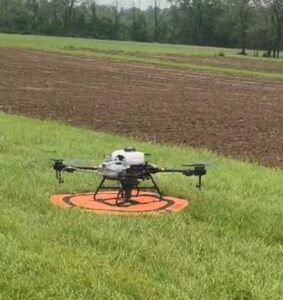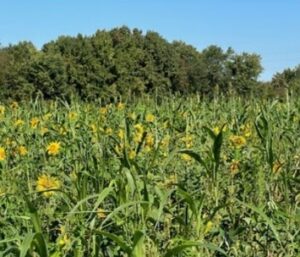The Northeast Cover Crops Council will host a fall webinar series. The webinars will take place from 12-1 pm on Wednesdays from October 1 to November 5, 2025. Click here to register for the series. [Read more…]
NJDA Updates on HPAI: Cases in New Jersey this Year, and a Recommendation to Tighten Biosecurity before Fall Migration
State officials are urging backyard poultry owners to strengthen their biosecurity practices following a series of Highly Pathogenic Avian Influenza (HPAI) detections across New Jersey earlier this year.
Between February and May 2025, the New Jersey Department of Agriculture (NJDA) confirmed HPAI at eight locations, including two backyard flocks in Salem and Atlantic counties, and six live bird markets. The virus, which is highly contagious and often fatal to domestic poultry, has also been found in wild birds across 16 counties, most recently in black vultures in Somerset County, according to the New Jersey Department of Environmental Protection (NJDEP).
As Fall migration season begins, state officials warn that interactions between wild birds and backyard flocks may increase, thus raising the risk of transmission. These interactions include: direct contact and/or the sharing of waterers, feeders, or swimming areas. This kind of direct exposure can be a potential source of disease transmission to domestic poultry, especially because HPAI can spread through contact with infected birds’ bodily fluids or contaminated surfaces like feeders, waterers, shoes, and equipment. Backyard poultry flocks in New Jersey are particularly at risk due to their smaller size and frequent exposure to wild birds or their droppings.
Strong biosecurity practices are key to protecting poultry from infection, and the NJDA is urging all poultry owners (including farms with multiple species, like poultry and ruminants) to stay vigilant and implement strict biosecurity protocols. Multi-species farms should evaluate and strengthen biosecurity measures to reduce the risk of cross-species disease transmission. Key biosecurity steps include securing housing against wildlife, reducing environmental attractants like standing water and uncovered feed, limiting human and equipment traffic, and regularly disinfecting surfaces and tools. Separate clothing and footwear for poultry care, or the use of disposable boot covers, is also recommended. The NJDOH also recommends wearing personal protective equipment (PPE) when handling sick or dead birds. PPE can be obtained through a request to your local Rutgers Cooperative Extension county office.
The NJDA, in collaboration with the New Jersey Department of Health (NJDOH) and other partners, continues to monitor and respond to the H5N1 threat. HPAI is a reportable disease, so suspected cases must be reported to the NJDA Division of Animal Health at 609-671-6400. For wild bird mitigation support, contact USDA Wildlife Services at 908-735-5654.
As a reminder, signs of HPAI in poultry include:
- Sudden death
- Reduced appetite or water intake
- Coughing, sneezing, or nasal discharge
- Swelling around the eyes or face
- Open-mouth breathing
- Discolored combs or legs
- Drop in egg production
- Lethargy
For more information, including additional resources regarding biosecurity plans, please refer to the memo from Dr. Amar Patil, DVM, MVSc, Ph.D., Diplomate ACVM, Director of the Division of Animal Health/State Veterinarian: 2025 HPAI Letter to BYF Poultry Owners_SEPT
Networks to Reduce Risk: Annie’s Project – Info session
The program, “Networks to Reduce Risk: Annie’s Project Builds Viable Farms in Urban and Rural NJ” will include four unique field trips and a dynamic, six-part webinar series. The overarching goal of this program is to improve risk management strategies of urban and rural farm business owners by connecting them with interactive educational opportunities, practical resources, and each other. This program is open to all.
Interested participants can attend an upcoming informational session to learn more about the program objectives and activities, the expected benefits for participants, and receive information about program registration. The informational session will be held online via Zoom on Wednesday, September 24, 2025, from 7:00 pm to 8:00 pm. To register for the informational session, please visit go.rutgers.edu/ntrrinfosession. Registration is required.
All questions can be directed to anniesproject@njaes.rutgers.edu.

This work is supported by the Northeast Extension Risk Management project award no. 2024-70027-42540, from the U.S. Department of Agriculture’s National Institute of Food and Agriculture. Thank you so much in advance!
Spanish Course for Ag Workforce – Registration Open
 The Rutgers Office of Continuing Professional Education will host a course on ‘Spanish for Ag and Horticulture Workforce’ from January 16-March 6, 2026. This is an online, self-paced course with approximately 21 hours of course content designed to help participants study conversational Spanish and gain technical vocabulary specific to those in the agriculture and horticulture workforce.
The Rutgers Office of Continuing Professional Education will host a course on ‘Spanish for Ag and Horticulture Workforce’ from January 16-March 6, 2026. This is an online, self-paced course with approximately 21 hours of course content designed to help participants study conversational Spanish and gain technical vocabulary specific to those in the agriculture and horticulture workforce.
There is a registration fee of $825 per person. Register by January 9, 2026 for the early bird registration rate of $795.
For more information and to register, visit https://cpe.rutgers.edu/spanish-for-ag-and-horticulture-workforce.
Upcoming NJDA Poultry Webinar
Upcoming Webinar: “For the Birds! Health Concerns of Poultry and How to Keep Them Safe”
Join the New Jersey Department of Agriculture for a free virtual webinar focused on the health and safety of backyard poultry flocks. Learn about common poultry health issues, like avian influenza, and discover practical steps to protect your birds. The event will feature a 45-minute presentation, followed by a 15-minute Q&A session with NJDA Animal Health experts. This event is catered to poultry and livestock owners, hobbyists, and anyone involved in animal health and agriculture.
🗓 Date: Tuesday, September 16, 2025
🕕 Time: 6:00 PM – 7:00 PM
💻 Location: Virtual
🔗 Register now via the QR code on the flyer
Rutgers to Host Afternoon Cover Crops Field Day – August 5
Rutgers Cover Crops Field Day
*The program may be rescheduled in the event of inclement weather*
Date: August 5, 2025
Time: 3:00PM to 6:00 PM
Where: Snyder Research Farm, 140 Locust Grove Rd, Pittstown, NJ 08867
REGISTRATION REQUIRED:
Please register by calling RCE of Sussex County: 973-948-3040
*First 20 registrants will receive a FREE copy of the USDA SARE book: “Managing Cover Crops Profitably”
This event will highlight several cover crop research projects and foster discussion and networking on drone use in agriculture and cover crop management.
Please join us for this summer event.
We will also discuss an upcoming drone pilot certification training we will be hosting this winter.
3:00 PM Registration and Welcome – Stephen Komar, ANR Agent /Rutgers SARE Coordinator
3:15 PM Go to the Field – Calibrating a Drone for Agricultural Applications – Adam Kyle, Warren Co. Com. College, Teaching Administrator, Precision Agriculture, Stephen Komar
4:00 PM Summer Cover Crop Planting Comparison: Drone vs. Drill – Bill Bamka, ANR Agent
4:30 PM Row Middle Cover Crops vs Herbicides for Weed Management in Vegetable Culture – Kate Brown, ANR Agent
RC&D Cover Crop Programs- Laura Tessieri, Executive Director, North Jersey RC&D
Drone Seeding Cover Crops into Pumpkins – Peter Nitzsche, ANR Agent
5:30 PM Update on Worker Protection Standards and Pesticide Recordkeeping – Michelle Infante-Casella, ANR Agent
6:00 PM Pesticide Credits and Adjourn



This event is sponsored by a grant awarded to Stephen Komar (Principal Investigator), Michelle Infante-Casella, and William Bamka Agricultural Agents/Professors, Rutgers Cooperative Extension, by the USDA, Sustainable Agriculture Research and Education, Professional Development Program.
